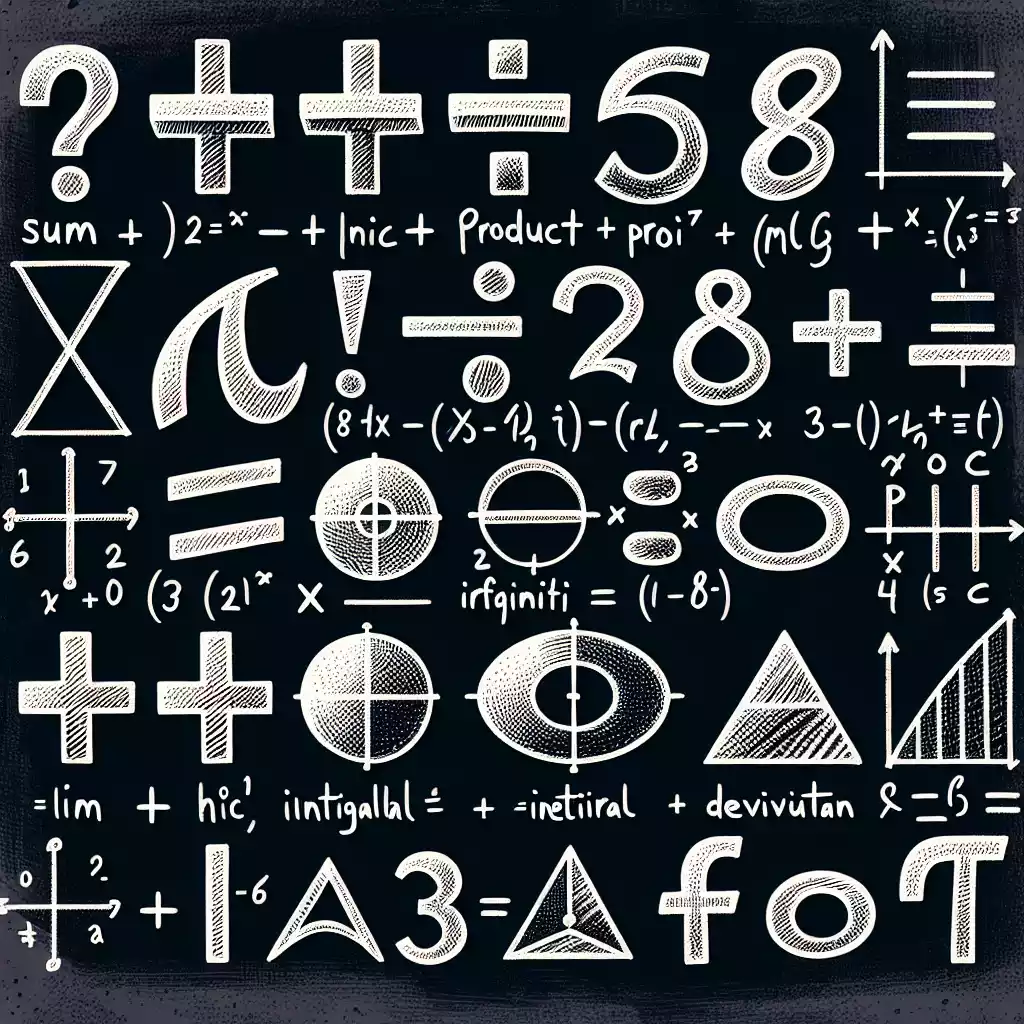Mathematics is often described as the universal language, a system of communication that transcends cultural and linguistic barriers. This language is built on a foundation of symbols and notations that convey complex ideas succinctly and precisely. From the ancient Greeks who laid the groundwork for geometry to modern-day mathematicians developing new theories, the symbols and language of mathematics have evolved to become an essential tool in science, engineering, economics, and beyond.
The beauty of mathematical symbols lies in their ability to represent intricate concepts with simplicity. For instance, the symbol π (pi) encapsulates the ratio of a circle’s circumference to its diameter, a concept that has fascinated mathematicians for centuries. Similarly, algebraic symbols like x and y allow us to solve equations and understand relationships between variables. These symbols are not just arbitrary marks; they are the building blocks of mathematical thought.
Understanding these symbols is crucial for anyone looking to delve deeper into mathematics. Whether you’re a student grappling with algebra for the first time or a professional applying calculus in your field, a solid grasp of mathematical language can open doors to new insights and discoveries. In this article, we’ll explore the various symbols used in mathematics, their meanings, and their applications. We’ll also provide tips for mastering these symbols and avoiding common mistakes.
The Importance of Mathematical Language
Mathematical language serves as a bridge between abstract concepts and real-world applications. It allows us to model phenomena, solve problems, and communicate ideas with precision. The development of mathematical notation has a rich history, with contributions from various cultures and eras.
Historical Context of Mathematical Language
The origins of mathematical symbols can be traced back to ancient civilizations. The Babylonians used a base-60 number system, while the Egyptians developed hieroglyphs for numbers. The Greeks introduced symbols for geometric figures and the concept of zero, which was later refined by Indian mathematicians. The modern notation we use today, including the use of letters to represent variables, was largely developed during the Renaissance.
Role in Modern Mathematics
In contemporary mathematics, symbols are indispensable. They enable mathematicians to express complex ideas succinctly and to manipulate equations efficiently. For example, the use of sigma (Σ) notation allows for the concise representation of summation, a fundamental operation in calculus and statistics. Without these symbols, mathematical communication would be cumbersome and prone to errors.
Basic Mathematical Symbols
Understanding basic mathematical symbols is the first step in mastering the language of mathematics. These symbols are used in arithmetic, algebra, and beyond.
Arithmetic Symbols
Arithmetic symbols are the foundation of mathematical operations. They include:
• Addition (+): Represents the sum of two or more numbers.
• Subtraction (-): Indicates the difference between two numbers.
• Multiplication (×): Denotes the product of two numbers.
• Division (÷): Signifies the quotient of two numbers.
Comparison Symbols
Comparison symbols are used to compare values. They include:
• Equal to (=): Indicates that two values are the same.
• Not equal to (≠): Shows that two values are different.
• Greater than (>): Means one value is larger than another.
• Less than (<): Means one value is smaller than another.
Advanced Mathematical Symbols
As you progress in mathematics, you’ll encounter more advanced symbols that represent complex concepts.
Algebraic Symbols
Algebraic symbols are used to represent variables, constants, and coefficients in equations.
• Variables (x, y, z): Represent unknown values that can change.
• Constants (a, b, c): Represent fixed values.
• Coefficients: Numbers that multiply variables in an equation.
Calculus Symbols
Calculus introduces symbols for derivatives and integrals, which are used to study change and accumulation.
• Derivatives (d/dx): Represent the rate of change of a function.
• Integrals (∫): Represent the accumulation of quantities.
Set Theory Symbols
Set theory symbols are used to describe collections of objects.
• Union (∪): Represents the combination of two sets.
• Intersection (∩): Represents the common elements of two sets.
• Element of (∈): Indicates that an object belongs to a set.
Greek Letters in Mathematics
Greek letters are frequently used in mathematical notation to represent constants, variables, and functions.
Commonly Used Greek Letters
• Pi (π): Represents the ratio of a circle’s circumference to its diameter.
• Sigma (Σ): Used to denote summation.
• Delta (Δ): Represents change or difference.
Applications of Greek Letters
Greek letters are used in various branches of mathematics, including geometry, calculus, and statistics. For example, delta (Δ) is often used to represent a change in a variable, while sigma (Σ) is used to denote the sum of a series.
Logical Symbols in Mathematics
Logical symbols are used to represent logical operations and relationships.
Basic Logical Symbols
• And (∧): Represents the logical conjunction of two statements.
• Or (∨): Represents the logical disjunction of two statements.
• Not (¬): Represents the negation of a statement.
Quantifiers
Quantifiers are used to express the extent to which a statement is true.
• Universal Quantifier (∀): Indicates that a statement is true for all elements in a set.
• Existential Quantifier (∃): Indicates that there exists at least one element in a set for which the statement is true.
Geometric Symbols
Geometric symbols are used to represent shapes, figures, and their properties.
Points, Lines, and Angles
• Point (•): Represents a location in space.
• Line (—): Represents a straight path extending in both directions.
• Angle (∠): Represents the space between two intersecting lines.
Shapes and Figures
• Triangle (△): A three-sided polygon.
• Circle (○): A round shape with all points equidistant from the center.
• Square (□): A four-sided polygon with equal sides and right angles.
Statistical Symbols
Statistical symbols are used to represent data and statistical measures.
Descriptive Statistics Symbols
• Mean (x̄): Represents the average of a set of values.
• Standard Deviation (σ): Measures the dispersion of a set of values.
Inferential Statistics Symbols
• Probability (P): Represents the likelihood of an event occurring.
• Chi-Square (χ²): Used in hypothesis testing to compare observed and expected frequencies.
Common Mistakes with Mathematical Symbols
Misunderstanding or misusing mathematical symbols can lead to errors in calculations and interpretations.
Misinterpretation of Symbols
One common mistake is confusing similar-looking symbols, such as the equal sign (=) and the assignment operator (:=). Another is misinterpreting the meaning of symbols in different contexts, such as using the plus sign (+) for both addition and concatenation in programming.
Incorrect Usage in Equations
Errors can also arise from incorrect usage of symbols in equations. For example, forgetting to apply parentheses in expressions can lead to incorrect results. It’s important to follow the order of operations and use symbols correctly to avoid mistakes.
Tips for Mastering Mathematical Symbols
Mastering mathematical symbols requires practice and familiarity. Here are some tips to help you along the way:
Practice Regularly
Regular practice is key to becoming proficient with mathematical symbols. Work on problems that involve different symbols and notations to build your skills.
Use Reference Guides
Keep a reference guide or cheat sheet handy to quickly look up symbols and their meanings. This can be especially helpful when learning new concepts.
Conclusion
Mathematical language and symbols are essential tools for understanding and communicating complex ideas. From basic arithmetic to advanced calculus, these symbols provide a concise and precise way to represent mathematical concepts. By mastering these symbols, you can unlock new insights and solve problems more effectively.
FAQs
What is the significance of mathematical symbols in learning mathematics?
Mathematical symbols play a crucial role in learning mathematics as they provide a universal language for expressing complex ideas succinctly. These symbols allow students to understand and solve problems more efficiently. For example, the symbol π (pi) represents the ratio of a circle’s circumference to its diameter, a concept that is fundamental in geometry. Without such symbols, mathematical communication would be cumbersome and prone to errors. Understanding these symbols is essential for anyone looking to delve deeper into mathematics and apply it in various fields.
How can I remember the different mathematical symbols?
Remembering mathematical symbols can be challenging, but there are several strategies that can help. One effective method is to create flashcards with the symbol on one side and its meaning on the other. Regularly reviewing these flashcards can reinforce your memory. Another approach is to practice using the symbols in different contexts, such as solving problems or writing equations. Associating symbols with real-world examples can also aid in retention. For instance, thinking of the symbol ∑ (sigma) as a sum of a series can make it easier to remember.
What are the most commonly used mathematical symbols in algebra?
In algebra, several symbols are frequently used to represent variables, constants, and operations. Some of the most common symbols include:
• Variables (x, y, z): Represent unknown values that can change.
• Constants (a, b, c): Represent fixed values.
• Coefficients: Numbers that multiply variables in an equation.
• Addition (+): Represents the sum of two or more numbers.
• Subtraction (-): Indicates the difference between two numbers.
• Multiplication (×): Denotes the product of two numbers.
• Division (÷): Signifies the quotient of two numbers.
Understanding these symbols is essential for solving algebraic equations and understanding relationships between variables.
How do Greek letters enhance mathematical notation?
Greek letters are frequently used in mathematical notation to represent constants, variables, and functions. They enhance mathematical notation by providing a concise and standardized way to express complex concepts. For example, the Greek letter π (pi) represents the ratio of a circle’s circumference to its diameter, a fundamental concept in geometry. Similarly, the Greek letter Σ (sigma) is used to denote summation, a key operation in calculus and statistics. Using Greek letters allows mathematicians to communicate ideas more efficiently and avoid confusion with other symbols.
What are the common errors to avoid when using mathematical symbols?
When using mathematical symbols, it’s important to avoid common errors that can lead to incorrect results. One common mistake is confusing similar-looking symbols, such as the equal sign (=) and the assignment operator (:=). Another error is misinterpreting the meaning of symbols in different contexts, such as using the plus sign (+) for both addition and concatenation in programming. Additionally, forgetting to apply parentheses in expressions can lead to incorrect results. To avoid these errors, it’s important to follow the order of operations and use symbols correctly.
—
Tables:
Basic Arithmetic Symbols
| Symbol | Meaning | Example |
|---|---|---|
| + | Addition | 3 + 2 = 5 |
| – | Subtraction | 5 – 2 = 3 |
| × | Multiplication | 3 × 2 = 6 |
| ÷ | Division | 6 ÷ 2 = 3 |
Comparison Symbols
| Symbol | Meaning | Example |
|---|---|---|
| = | Equal to | 3 + 2 = 5 |
| ≠ | Not equal to | 3 + 2 ≠ 6 |
| > | Greater than | 5 > 3 |
| < | Less than | 3 < 5 |
Algebraic Symbols
| Symbol | Meaning | Example |
|---|---|---|
| x, y, z | Variables | x + 2 = 5 |
| a, b, c | Constants | y = ax + b |
| 3x | Coefficient | 3x + 2 = 11 |
Calculus Symbols
| Symbol | Meaning | Example |
|---|---|---|
| d/dx | Derivative | d/dx (x^2) = 2x |
| ∫ | Integral | ∫ x dx = (1/2)x^2 + C |
Set Theory Symbols
| Symbol | Meaning | Example |
|---|---|---|
| ∪ | Union | A ∪ B |
| ∩ | Intersection | A ∩ B |
| ∈ | Element of | x ∈ A |
Greek Letters in Mathematics
| Symbol | Meaning | Example |
|---|---|---|
| π | Pi | π ≈ 3.14159 |
| Σ | Summation | Σ x_i |
| Δ | Delta | Δy/Δx |
Logical Symbols in Mathematics
| Symbol | Meaning | Example |
|---|---|---|
| ∧ | And | P ∧ Q |
| ∨ | Or | P ∨ Q |
| ¬ | Not | ¬P |
| ∀ | Universal Quantifier | ∀x (P(x)) |
| ∃ | Existential Quantifier | ∃x (P(x)) |
Geometric Symbols
| Symbol | Meaning | Example |
|---|---|---|
| • | Point | A • B |
| — | Line | AB |
| ∠ | Angle | ∠ABC |
| △ | Triangle | △ABC |
| ○ | Circle | ○O |
| □ | Square | □ABCD |
Statistical Symbols
| Symbol | Meaning | Example |
|---|---|---|
| x̄ | Mean | x̄ = (Σx_i)/n |
| σ | Standard Deviation | σ = √(Σ(x_i – x̄)²/n) |
| P | Probability | P(A) = n(A)/n(S) |
| χ² | Chi-Square | χ² = Σ((O_i – E_i)²/E_i) |
—
This comprehensive guide covers the essential mathematical symbols and their meanings, providing a solid foundation for anyone looking to understand and use mathematical language effectively.
Mathematical Language and Symbols || Mathematics in the …
Welcome to the AI Blogging World! No need to stick with old-school methods anymore. I use AI to help you, but it won’t leave any footprint behind. With over 7 years of experience in content writing and digital marketing, you’re in the right place. From my personal experience, I know what format and quality Google loves for your blog. You’ll get the best results using this AAA tool.






